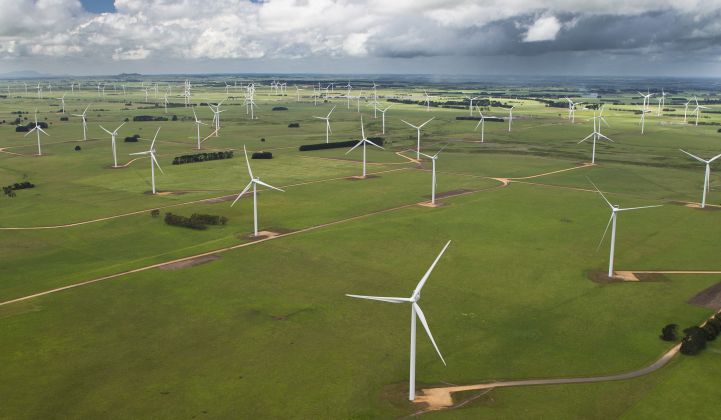Advanced Microgrid Solutions branched out of commercial storage development in 2017, promising big things in the energy software space. Last October, the company signaled an interest in Australia's fast-paced energy market. A period of radio silence ensued.
The quiet period is over. In the intervening time, AMS signed five commercial contracts in Australia to algorithmically dispatch 2,000 megawatts of renewables and storage, founder and CEO Susan Kennedy said in a recent interview.
"They’re really the leading edge of a revolution in the way the energy markets are going to be run and renewables integrated into the grid," said Kennedy, who previously served as chief of staff to California Governor Arnold Schwarzenegger.
The startup chose Australia as its entry market primarily because it has a real-time competitive energy market, where power producers are free to bid as they choose to maximize their returns. The market has seen a dramatic rise in renewable generation, particularly in the south, as well as retirement of coal baseload plants.
The new renewable plants have effectively zero marginal cost to operate, because their fuel (i.e., wind and sun) is free. That leads traders to enter them at the minimum bid, so they always dispatch. However, moments of oversupply — a strong gust of wind hitting several wind plants, for instance — can drive prices into negative territory. Dispatching into the market at those times loses money.
Market conditions like that can be difficult if not impossible for a human to anticipate and react to. The advent of battery storage, which can charge or discharge to take advantage of market conditions, only makes the decision more complicated. That's where AMS believes artificial intelligence can help.
"A battery cannot be managed by humans with Excel spreadsheets — there are too many variables," Kennedy said. "Five to 10 years from now, you will not see a trading desk in the world that does not have some AI support tools, if it's not fully automated."
Digitally capturing all those variables took much of the intervening time since AMS announced its pivot from pure-play commercial storage development. It hired some of the talent that built Tesla's market optimization platform for the Hornsdale Power Reserve in South Australia. Then the company set about coding all the market rules for Australia's grid services and energy markets, as well as the physical operating parameters of the wind turbines, batteries, inverters and the other relevant equipment.
The model also has to capture customer commitments, much like AMS' early business of balancing discharge for local capacity with demand-charge management for the host customer. A front-of-the-meter power plant could stack multiple offtake agreements too.
In exchange for these services, AMS charges a subscription fee based on the type of asset and the incremental value that will be added by the software. The contract can also feature a low subscription price with a cut of the upside above a certain threshold.
A far cry from the original business model
An open question when AMS announced the new strategy was whether hardened renewable developers, or their financiers, would trust a Silicon Valley startup to manage the economic returns of their multimillion-dollar investments. The company needed to prove it could add value beyond the typical dispatch program a developer would already have.
So far, only one customer has publicly identified itself: Tilt Renewables, which initiated the software in July at its 100-megawatt Snowtown 1 Wind Farm in South Australia. Doing so enabled it to increase revenue during a period of market volatility and negative pricing, the company said in a statement, adding that it will expand the service to more facilities.
Since this is software, AMS can track assets in real market conditions, and then separately simulate how they would perform if they let the program take over control. The early adopters of the platform tend to be the equity investors in renewables projects, Kennedy said. They can see what their asset is making under its current bidding strategy and compare to the money it could be making.
For instance, one wind farm increased revenue by as much as AUD $300,000 (USD $204,000) in its first two months using the AMS platform, while other wind farms in the region suffered substantial losses by continuing to dispatch during negative pricing, Kennedy said. AMS also estimates that a neighboring wind farm would have earned an additional AUD $109,000 in a 48-hour period if it had been using AMS' software.
Developers elsewhere will soon have a chance to test out the service. AMS is preparing to launch the trading platform in California's CAISO wholesale market, and it has more than 1,000 megawatts already in development there for what it describes as "a large utility."
The company also plans to expand to ERCOT, an energy-only market much like Australia's, as well as the U.K. and other markets in 2020. The team is coding different resource modules to control assets like EV chargers and pumped hydro storage.
Strategically turning off wind farms may seem like a far cry from the original business model of installing and operating batteries at commercial properties, but both tasks grapple with the changing nature of the decarbonizing grid.
High renewable penetrations make electrical supply more variable, forcing grid operations to become more flexible in response. Batteries can manage that flexibility, but incur a steep capital expense; for a much smaller price, software can address the supply side, removing energy supply at moments that would aggravate a surplus on the wires.




